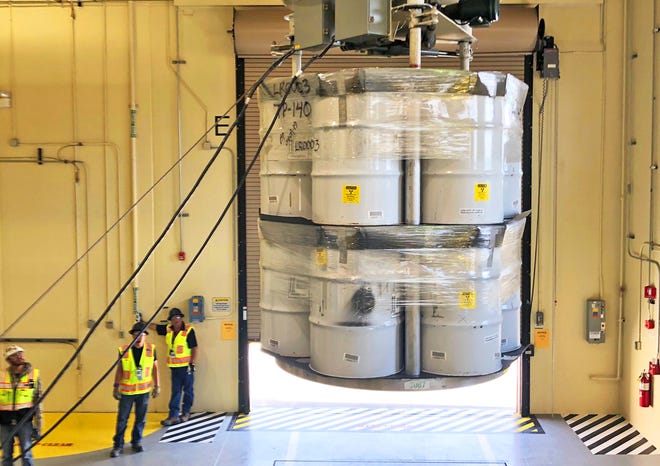A new company could be sought to ship nuclear waste to the Waste Isolation Pilot Plant near Carlsbad for disposal from generator sites across the county.
The U.S. Department of Energy announced on June 10 it issued a request for proposal (RFP) for the transportation contract for WIPP, seeking interested firms and proposals for the work and its potential costs.
The contract would carry with it a five-year operating period starting after the present contract with Cast Specialty Transportation expires on May 27, 2022.
More:What’s going on at WIPP? Construction projects ongoing at nuclear waste facility
CAST was awarded the current contract in 2017, its fifth in a row since 2000, with an estimated value of $112 million for a five year performance period and 60-day transition.
Previously, WIPP used two transportation firms to move waste to the facility, where it is disposed of in a salt bed about 2,000 feet underground.
In 2012, CAST and Visionary Solutions LLC were awarded contracts for the work and the 2017 award was the first time in WIPP’s history that the DOE contracted with only one company.
More:WIPP: Nuclear waste shipments from Washington delayed 20 years by 2014 release

What does the contract require?
The contract would include firm-fixed-price task orders, per the release, and an indefinite delivery/indefinite quantity contract that allows the DOE to specify tasks required, their budget and timeline.
In return, the selected company would receive an annual fee, and would be reimbursed for permitting costs, New Mexico gross receipts taxes, fuel and a safe-driving bonus.
The chosen contractor would be provided with facilities, personnel, and equipment to operate a local terminal within a 10-mile perimeter of Carlsbad and transportation and maintenance services need to support WIPP.
More:Utility shaft at Waste Isolation Pilot Plant debated during first day of State hearings
Drivers were not required to live in Carlsbad but must be able to respond to the terminal within four hours, records show.
A contractor was not required to already own and operate such a terminal in Carlsbad but would be required to establish the facility by the end of the transition into the new contract.
It was expected that the company would need to plan for about 1 to 2 million miles of travel per year, with WIPP carrier miles ranging over the past decade from 3 million to 300,000 miles annually, records show.
More:WIPP: Electric vehicles coming to nuclear waste repository, intended to improve airflow
That entails carrying both contact-handled (CH), or lower-level transuranic (TRU) nuclear waste and the higher-level remote-handled (RH) waste, along with mixed hazardous constituents.
TRU waste is made up of clothing and cloth materials like rags and debris and equipment exposed to radiation during nuclear activities like research and experimentation.
The waste is packaged into three types of containers for shipment of CH waste to WIPP: the TRUPACT II with a maximum payload weight of 7,265 pounds, the TRUPACT III with a maximum payload weight of 11,486 pounds, and the HalfPACT with a maximum payload weight of 7,600 pounds.
More:WIPP completes maintenance outage, intends to up shipments of nuclear waste post-pandemic
For RH waste, the DOE uses the RH-72B container, which has a maximum payload weight of 8,000 pounds, and includes a lead liner to further protect the waste from fire or other dangers.
Where does WIPP’s nuclear waste come from?
Transportation of the waste would occur from DOE sites throughout country and other defense-relates sites that generate TRU waste to the WIPP site near Carlsbad.
Transportation containers would originate at the WIPP site empty, before traveling to the generator site to drop off empty containers and loading up loaded casks.
More:Amid legal battles over WIPP air system rebuild, new contract awarded to finish the work
In the coming year, records show, the DOE expects between 500 to 800 loaded shipments.
Since opening in 1999, waste was shipped to WIPP from 13 DOE sites, on about 15.4 million lane miles of travel.
Idaho National Laboratory (INL) sent the most waste to WIPP at 6,550 shipments and covered the most distance at 9.1 million miles.
More:WIPP: Restart of ventilation fan needed for worker safety at nuclear repository
INL was followed by Rocky Flats Environmental Technology Site in Colorado with 2,045 shipments and 1.4 million miles of travel.
The third biggest shipper to WIPP was the Savannah River Site in South Carolina with 1,679 waste shipments, but that site had the second-most lane miles at 2.5 million.
Los Alamos National Laboratory in Los Alamos, New Mexico was next with 1,463 shipments and 500,346 traveled miles.
Adrian Hedden can be reached at 575-618-7631, achedden@currentargus.com or @AdrianHedden on Twitter.







